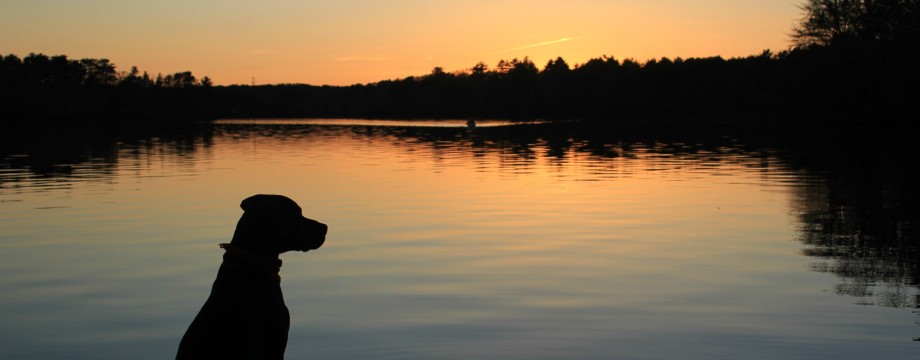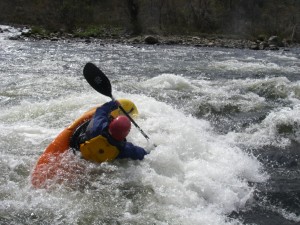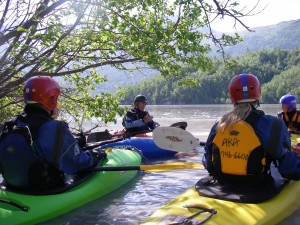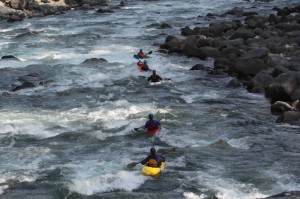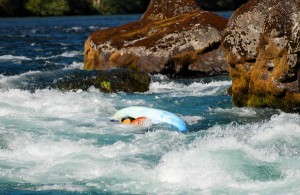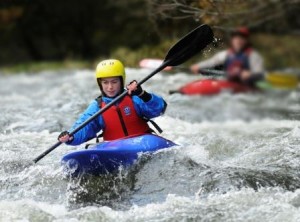There may come the time when you decide to dabble in some whitewater paddling. My adventures in whitewater paddling started when I joined the MIT Outing Club in graduate school. The sea kayaking season had just wrapped up but the whitewater folks were looking for some instructors to volunteer to teach winter pool sessions. This is when I dove down the rabbit hole…
It wasn’t long before the whitewater crew convinced their new Sea Kayaking Chair to take a break from the ocean a few times each month to join them on the river. The only problem was that they decided my many years of flat water paddling experience meant that I could circumvent the class 1-2 warm-ups and start with some moderate class 3 rivers. Let’s just say that my first few trips found me swimming as much as paddling!
Whitewater paddling is a great way for sea kayakers to improve their paddling skills but there are some key differences to consider when you get started. Here are a few things that I’ve learned and some tips to help soften your transition from flat water to whitewater:
Seek out qualified instruction
Should you be interested in trying out some whitewater then the best advice that I can give you is to seek out qualified instruction such as the Paddling School at Zoar Outdoor. Then align yourself with a group of experienced paddlers (the AMC, Outing Clubs, ect) who are willing to coach you along the way. Don’t make the same mistake that I did and assume that your years of flat water paddling experience make you qualified to dive in head first!
Learn how to read a river and know the hazards
Moving water is a powerful force and with it comes a host of objective hazards that sea kayakers are not used to. Rivers contain all sorts of stuff including rocks, downed trees, and man-made structures. Rocks create many of the whitewater features (waves, holes, ect) that paddlers enjoy playing on. However, they also provide the potential for a paddler to become pinned against them. Downed trees (called “strainers”) and man-made structures like dams can also get paddlers into serious trouble. To mitigate these risks, sea kayakers should educate themselves on the various river features. Learn which ones to avoid and what to do if you should come across them on the river. I learned a lot about reading the river by following more experienced paddlers, scouting rapids with them, and asking questions about why they liked one line over another.
Never paddle alone on whitewater
Whitewater paddling should always be considered a team sport. It takes a small group of paddlers to safely navigate a river and respond to any issues that may arise. Not to mention that it’s way more fun to have a few of your besties along for the ride! It was nice to have an audience the first time that I ran Zoar Gap so that they could tell me what I should have seen! Anyway, the message here is to save those solo paddling trips for the flat water!
Your Eskimo roll may not be as bomb-proof as you think…
Let’s face it…the Eskimo roll is something that usually sits in a sea kayaker’s bag of tricks but rarely ever gets tested. Roll sessions are a great way to develop and practice this skill but one should not confuse a 30 for 30 day at the pool for a bombproof roll. Paddling whitewater will expose your roll for what it really is (usually by blowing it up a few times). Bumping along a wave train upside down or recirculating in a hole feels very different than sitting static in a pool. It can be quite disorienting and requires one to be calm in the face of chaos which is something that is hard to learn in the pool!
I’ve found that the best way to develop a “bomb proof” roll is to start in the pool to practice the fundamentals and then seek out a friendly play wave to simulate the “chaos” of real-life river conditions. The best waves for roll practice are easily accessible and have a big eddy nearby. Push your limits in the wave until you capsize spontaneously and then attempt to roll. Do laps on the wave and capsize in different positions until you’re confident that you’ll roll up most of the time. Be sure to work on that off-side roll too!
Swim away from your kayak
Sea Kayakers are taught that your kayak is your island. I always stress the importance of locating your kayak after a wet exit and making sure to get ahold of it ASAP in my flat water rescue clinics. The exact opposite is true when it comes to whitewater paddling. That kayak of yours can become a hazard in its own right when you’re swimming next to it. Getting stuck between your kayak and a river feature could ruin your day. When I was getting started with whitewater my friends would always coach me to swim away from my kayak, assume the safe swim position, and get to an eddy as soon as I could. The more experienced paddlers would pick up the pieces and meet me on the bank.
Be aggressive!
Sea Kayakers are usually on the water to enjoy the scenery and take things easy. We’re not typically in a big rush to get from Point A to Point B. This passive style of paddling can lead to some bad habits on the river. For example, I was inclined to rely on static braces a bit too much when I first started paddling whitewater. It took me a few trips to realize that I was way better off paddling through the rapids with strong forward strokes than floating through them looking to brace. This can be a bit of a culture shock but embracing a more aggressive style of paddling will serve you well on the river.
Edge, edge, and edge some more!
This is where whitewater will make the sea kayaker a better paddler. Most of us ocean-goers know a thing or two about edging and appreciate its impact on boat handling. However, many of us are a little lazy when it comes to edging and prefer to rely on strokes first. My appreciation for edging grew exponentially the first time that I made an eddy turn and ended up in the drink! Handling a whitewater kayak is all about being on edge. This is where you get your control and prevent capsizing on everything from eddy turns to ferrying to surfing on that play wave. “Show your backside to the current and edge like you mean it” will become your mantra!
Happy Paddling!
-Kayak Dave


